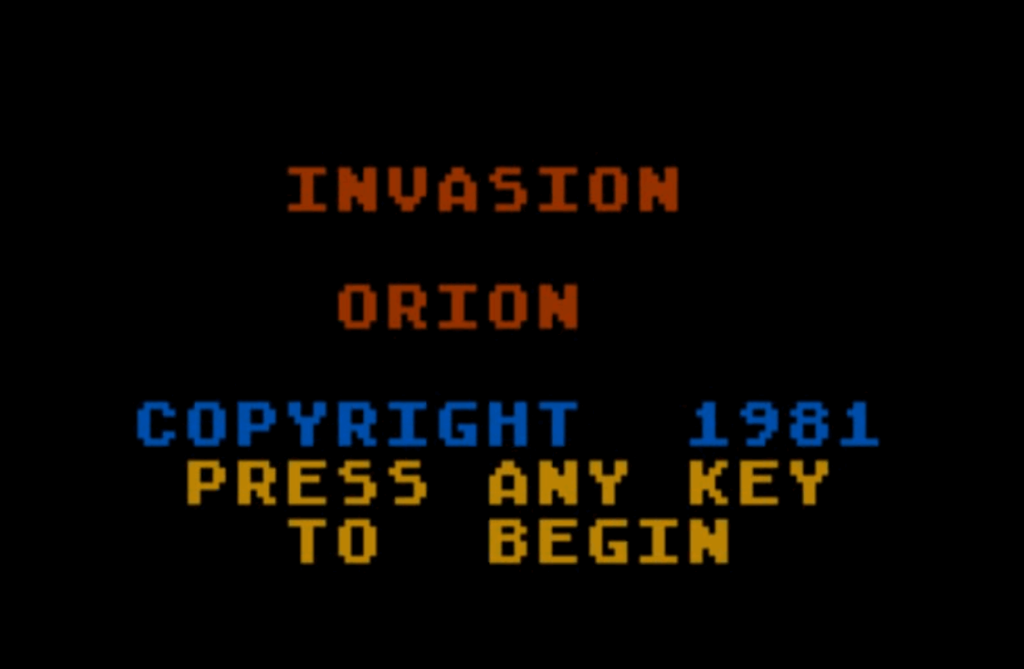
Welcome Cadets. Welcome to a historical moment : a common Stellar Union and Orion Colonies strategic briefing. I appreciate that so shortly after our mutual war, we can unite against this new threat.
During this briefing, we will cover all the engagements our two factions have had so far against the Klaatus, of which we know little. Pay close attention, soon, you may be the ones commanding our ships to battle !
Starfleet Orion was released in December 1978. As it is exclusively a two-players game, it would not have been on this blog if its authors, Jon Freeman and Jim Connely, had not realized the most challenging part of Starfleet Orion was finding someone to play with. They therefore released a single player version : Invasion Orion, less than one year later. While Invasion Orion adds an AI and a new campaign, both games use exactly the same engine and ruleset, and therefore it is possible to play Starfleet Orion‘s campaign in Invasion Orion. Of course, it is also possible to play Invasion Orion against a friend, with the caveat that the new scenarios are rarely balanced for that.
Both games were initially released on Commodore PET and TRS-80, and only later ported to Atari 8-bit and Apple II. The key difference between the platforms seems to be that the size of the map is significantly smaller on PET and Atari. Since almost nothing else is scaled down, I can only assume that combats are a lot more close and personal on Commodore and on Atari than they are on TRS-80 and Apple II.
Starfleet Orion describes the beginning of the Space Travel Age, possibly under the leadership of the Mormon Church (!) “any corporation, church, government, group or individual who could scrape up a few million dollars […] was building a starship“. This diverse group settled toward the “great stars of Orion” and colonized “the vast area between Rigel and Bellatrix”.
After this initial migration, people left behind on Earth united under the Stellar Union, and started a more organized colonization of the galaxy, until they reached the borders of the Orion Colonies. The scenario describes the very first clash, the following low intensity raids, the finding and usage by the Stellar Union of an ancient weapon, relic of a lost civilization, and the decisive final battle between the Stellar Union Starfleet and the eponymous Starfleet Orion.
Invasion Orion describes how an alien civilization – the Krells – created the Klaatu robots in their image, how eventually the Klaatus replaced the Krells and went exploring the galaxy, meeting humankind. The history of the battles between the Klaatus and humankind constitutes the scenario list of Invasion Orion.
First contact by the Stellar Union
Cadets, as you probably know, the very first contact with the Klaatus was made by the survey ship Eon Eagle. The Eon Eagle was approaching what her crew described as a peculiar asteroid with a strange pattern when they were attacked by ships that they could not identify. This was the tactical situation at that moment :
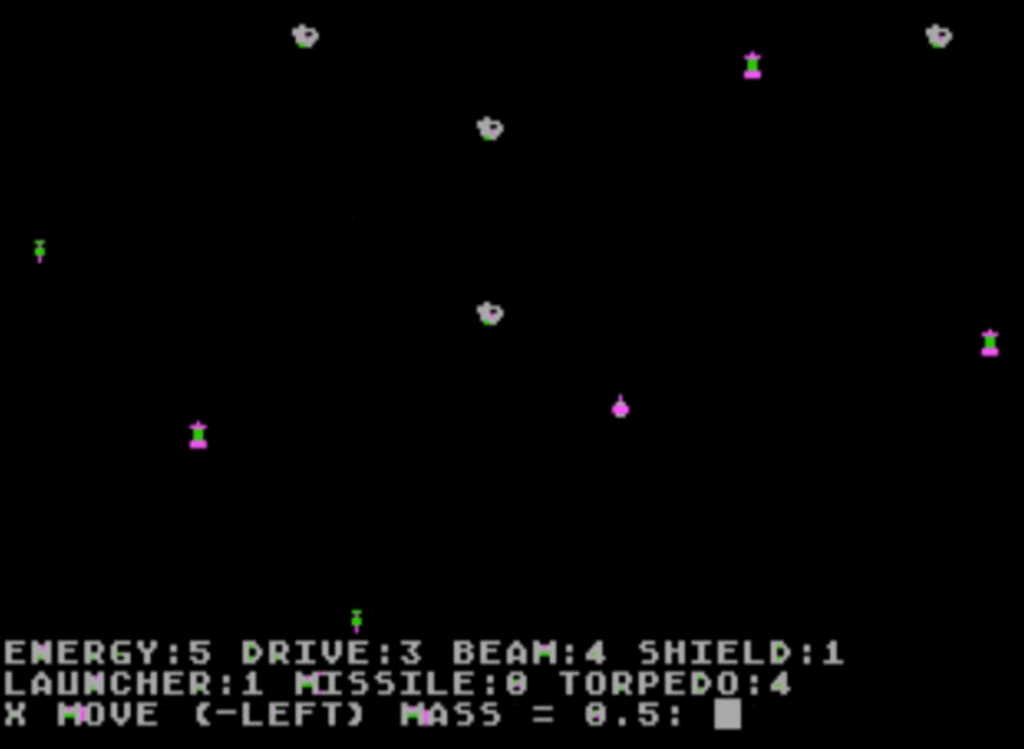
What ? You do not understand our tactical display ? Well, you better get used to it, that’s our standard battle display ! It is not Star Trek here ! Lieutenant Narwhal, please activate the information graphic.
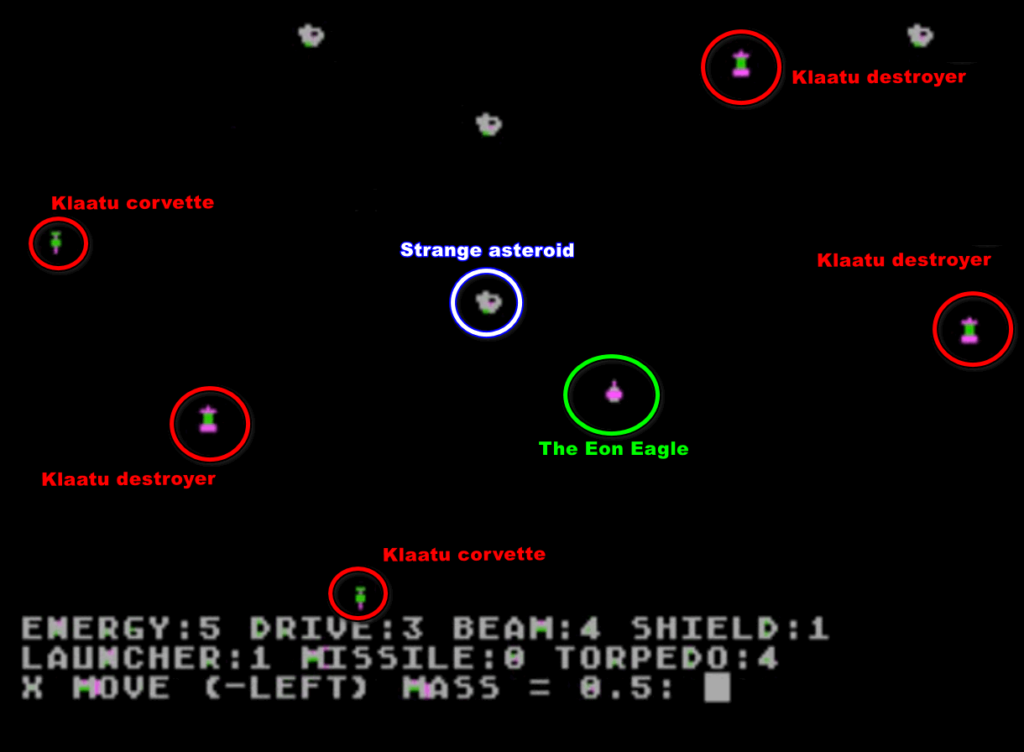
The objective for the Eon Eagle was to reach the asteroid to collect a sample, and after that she was supposed to – technical term here – bolt the freak out of the area. Now pay attention to this : the Eon Eagle was a small ship with only 5 energy and therefore the crew could only allocate 5 in energy to its different systems, including up to 3 to drive. With a mass of 0.5, that means it can travel up to 6 [3/0,5=6] distance units every time unit. The asteroid was at a distance at 5.8, so reachable in only one time unit. One energy was allocated to the shield – the maximum the shield could take, the rest was left unused.

The Eon Eagle reached the strange asteroid, and managed to collect the precious sample. I know there are some… misguided souls who claim that the Klaatus were only defending themselves, but this tactical display should make any doubt disappear : look at all the missiles exploding right where the Eon Eagle was !
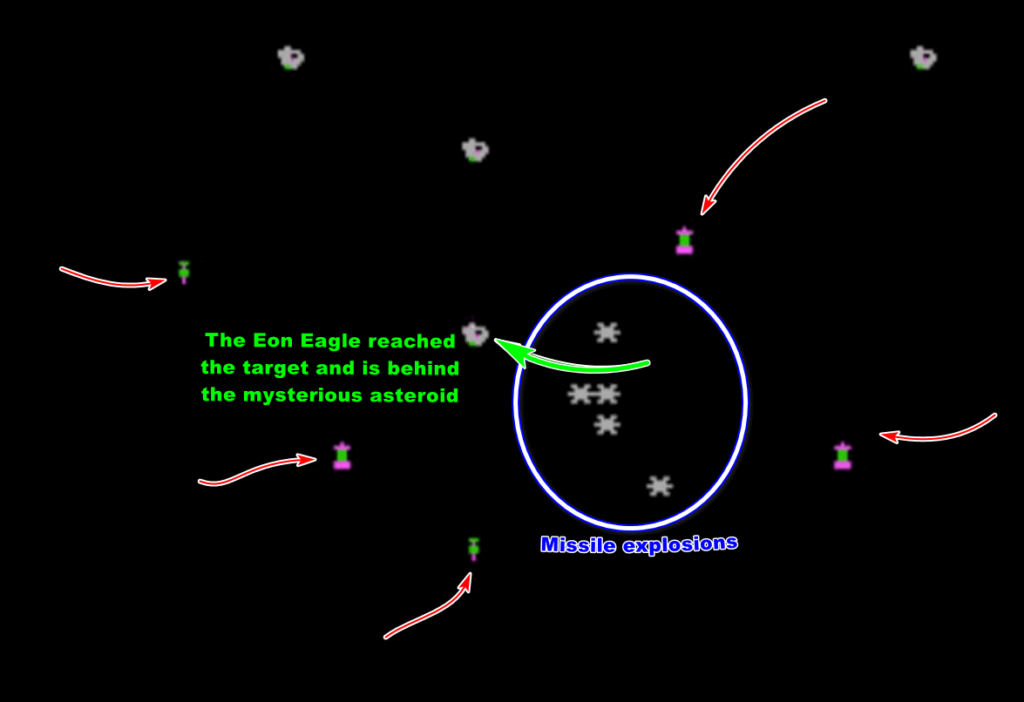
Not far from the mysterious asteroid there was a normal, honest-to-God asteroid which the Eon Eagle could use to protect herself against the enemy assault. It was exactly 6 distance units away and the Eon Eagle did not miss that opportunity :
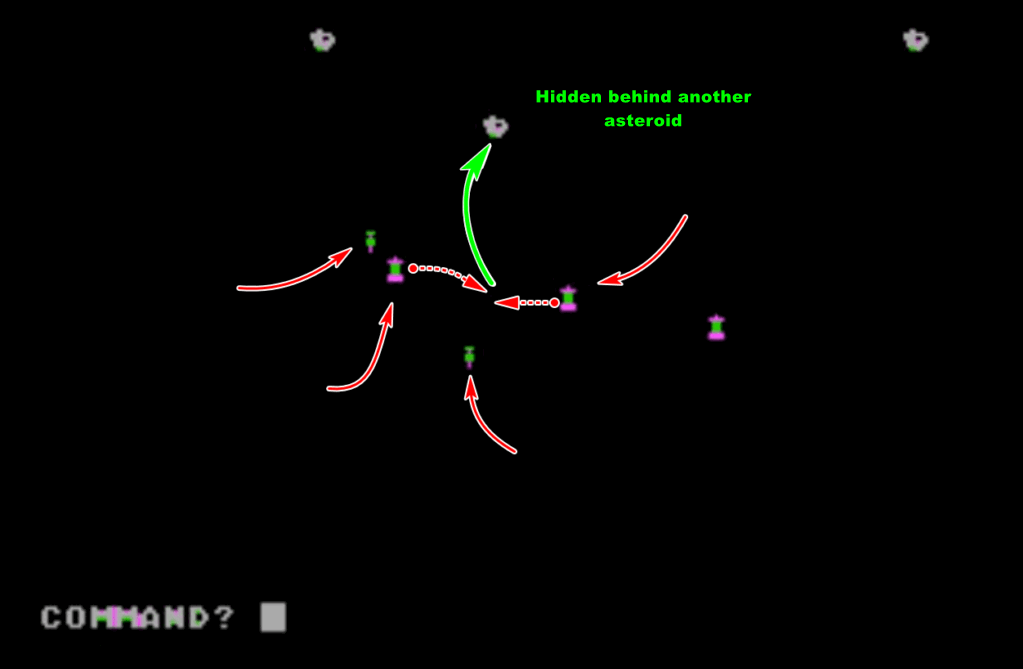
The Klaatus had closed the distance. Instead of missiles, they chose to use torpedoes, but luckily for the Eon Eagle, these hit the mysterious asteroid, destroying it, possibly on purpose. The Eon Eagle had only received minor damage from the beam weapons the enemy destroyers carried in addition to their missiles and torpedoes – its maximum energy had been decreased by one but that was manageable.
From her position, the Eon Eagle was only one time unit away from escape, and she jumped out of the area :
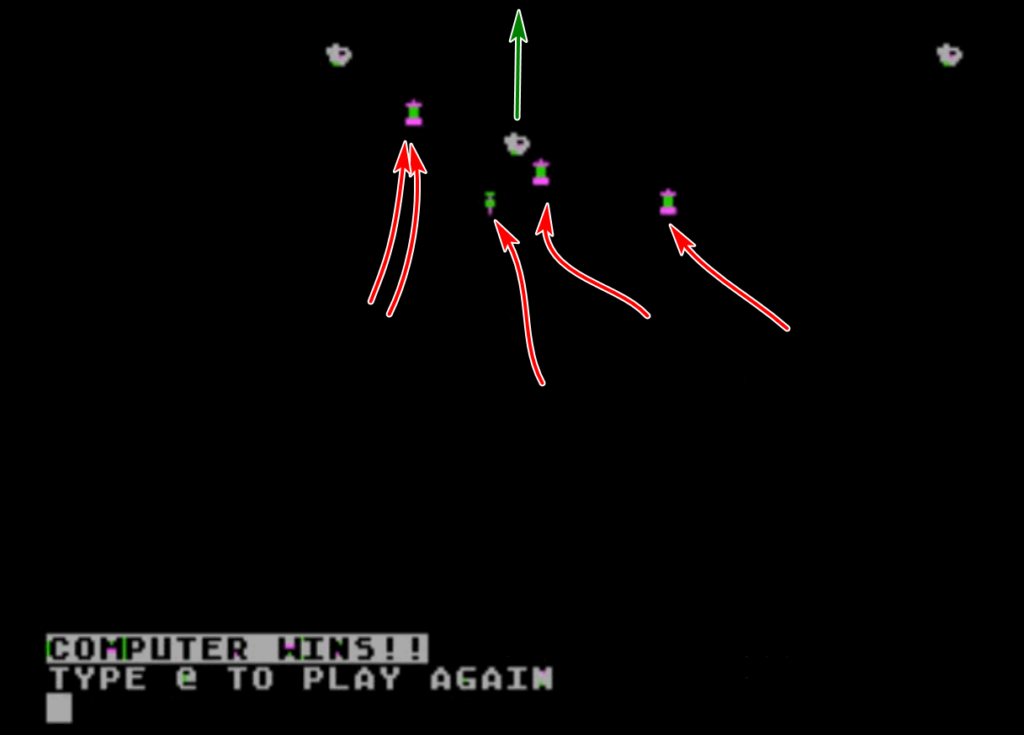
And so we have learned everything about drive and energy. Any questions ? Yes, Cadet Smith?
- You said the Eon Eagle was a survey ship. Why did she carry torpedoes and a beam weapon ?
Thank you Cadet Smith. Any other question ?
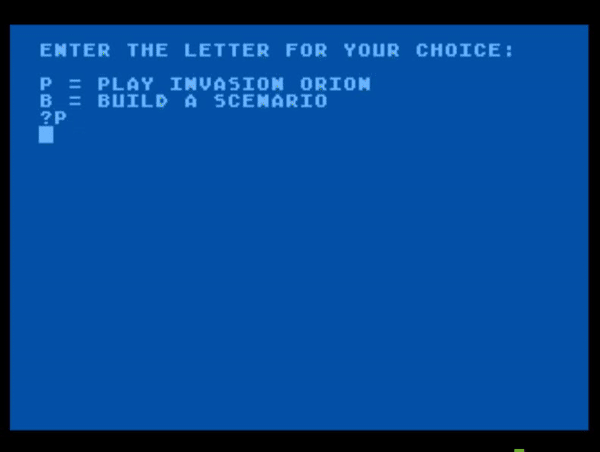
First battle by the Orion Colonies
At roughly the same moment as this first engagement by the Stellar Union, the freighter-turned- Battleship Camelot from the Orion Colonies detected an unknown warship. When the unknown ship engaged the Camelot, the latter had no choice but to answer in kind.
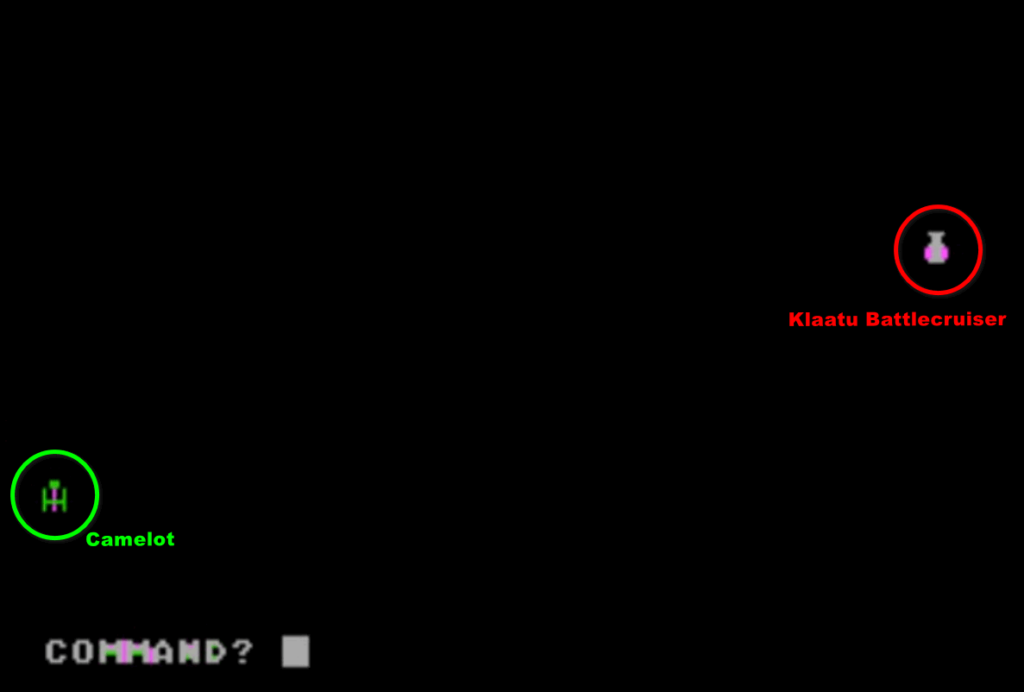
This was going to be a difficult fight. The Camelot was on all aspects less powerful than the Klaatu : less energy, less drive, a less powerful beam. Its own key advantage was the range of its torpedoes – 35 distance units (we know now that Klaatu torpedoes have a range of 25). Therefore, the strategy chosen by the crew of the Camelot was to keep its distance and shoot torpedoes. As you know, torpedoes go straight ahead in one of 8 directions ; should they detect anything at 2 distance units of its trajectory, friend, foe, asteroid, even missiles, it will lock on it and hit it.
And I have to say that the crew of the Camelot did wonders, hitting its target with 3 out of 4 torpedoes launched !
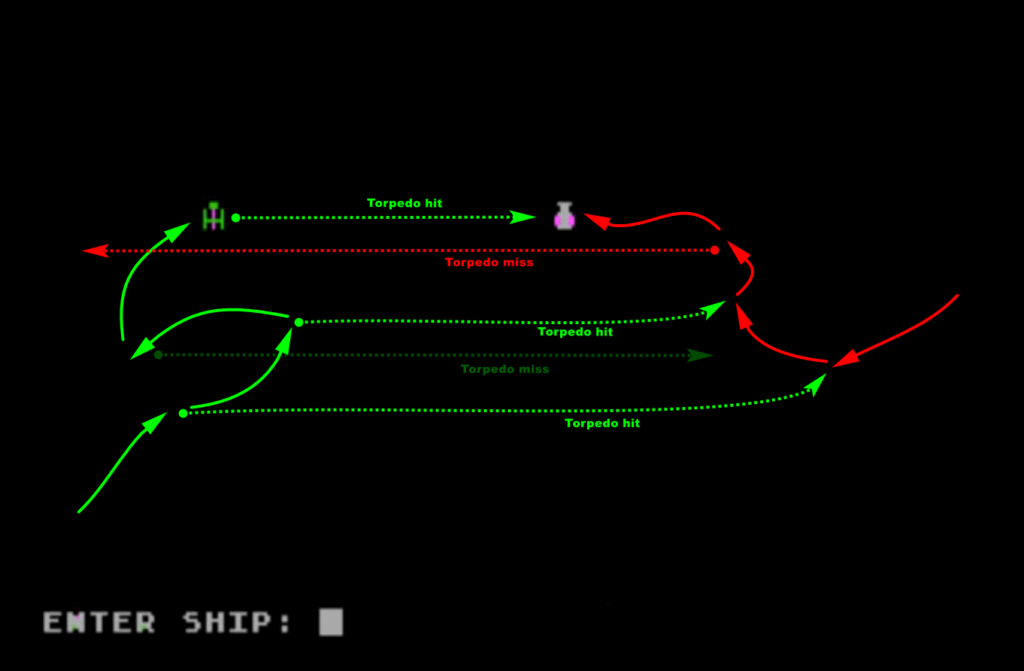
At this point, the Camelot was out of torpedoes, but she still had missiles. The Camelot has a launcher capacity of two, which means it can shoot two missiles by time unit. As I hope you know if you are in this room, unlike torpedoes, missiles must be aimed at a coordinate relative to the ship launching them, which makes them not very efficient against very mobile targets, except if you use them as a barrage, as the Klaatus do. They also explode, hitting anything one distance unit around where they exploded, though of course it is not going to be as painful as a direct hit.
In this case, the Klaatu Battlecruiser had been badly damaged, and its drive was mostly gone. The Weapon Officer of the Camelot therefore supposed that the Battlecruiser would move at most one distance unit… and he was correct.
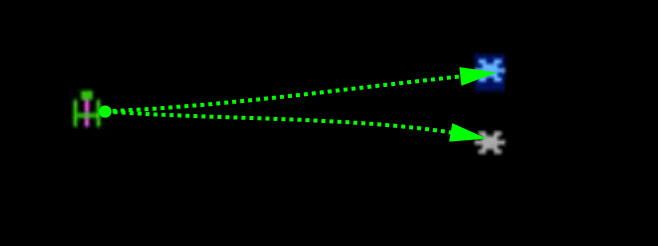
With this direct hit, the Battlecruiser was destroyed, and the battle was won. Any question ?
- Yes ! Here !
What is it, Cadet Smith ?
- You say that the Klaatu attacked the Camelot, but according to the tactical report we’ve just seen, the Camelot shot three torpedoes before the Klaatu even shot back. How did we know it was hostile ?
Because it was, Cadet Smith ! Because it was ! If there is no interesting question, we will proceed.
The Ambush of the Arès
We will now get into the nitty-gritty of the battle. There are not only long range missiles and torpedoes, sometimes you need to get close and personal. In this battle, the Arès, an Heavy Destroyer from the Stellar Union, was ambushed by two Klaatu Corvettes. Here is the order of battle:
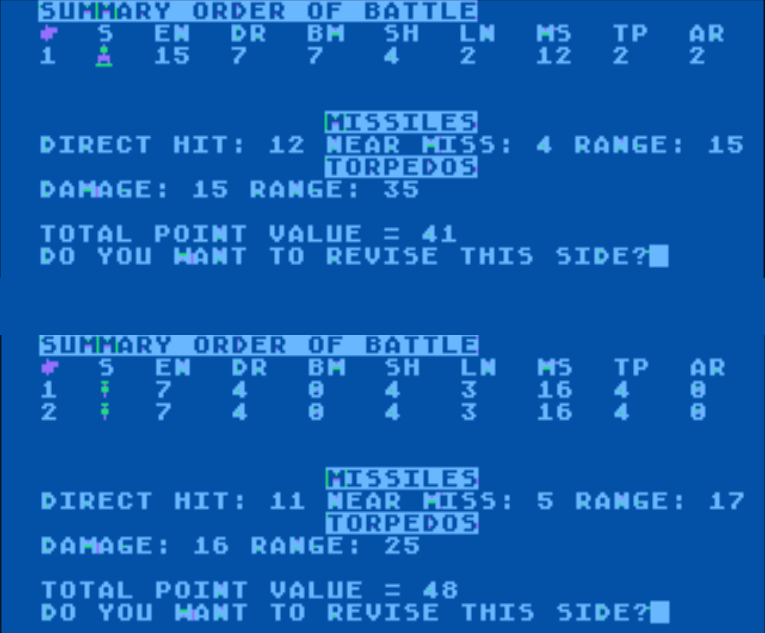
You recognize Energy (EN), Drive (DR) , Launcher (LN) and Shield (SH) . This also displays the number of Torpedoes (TP) and Missiles (MS). The missing ones are beam (BM), which you aim at a specific ship by allocating more or less energy to hit, and Armor (AR) which does not need allocation.
As you can see, as per their doctrine, the Klaatus embark a lot of launchers to saturate the space with missile explosions. The shield and armor of the Arès together could absorb a near miss (5 damage vs 6 absorption), but a direct hit was going to be back-breaking, as would be several near misses. The shield can only absorb in a given turn as much damage as the amount of energy allocated to it, whereas the armor does not need energy and absorb its value for each attack.
We did not expect the Klaatu to use their torpedoes, as for any ship only one torpedo can be shot every time unit,
On the other hand, the Klaatu Corvettes have no beam weapons, and one hit from our torpedoes is immediate destruction. The Arès turned confidently toward the enemy corvettes.
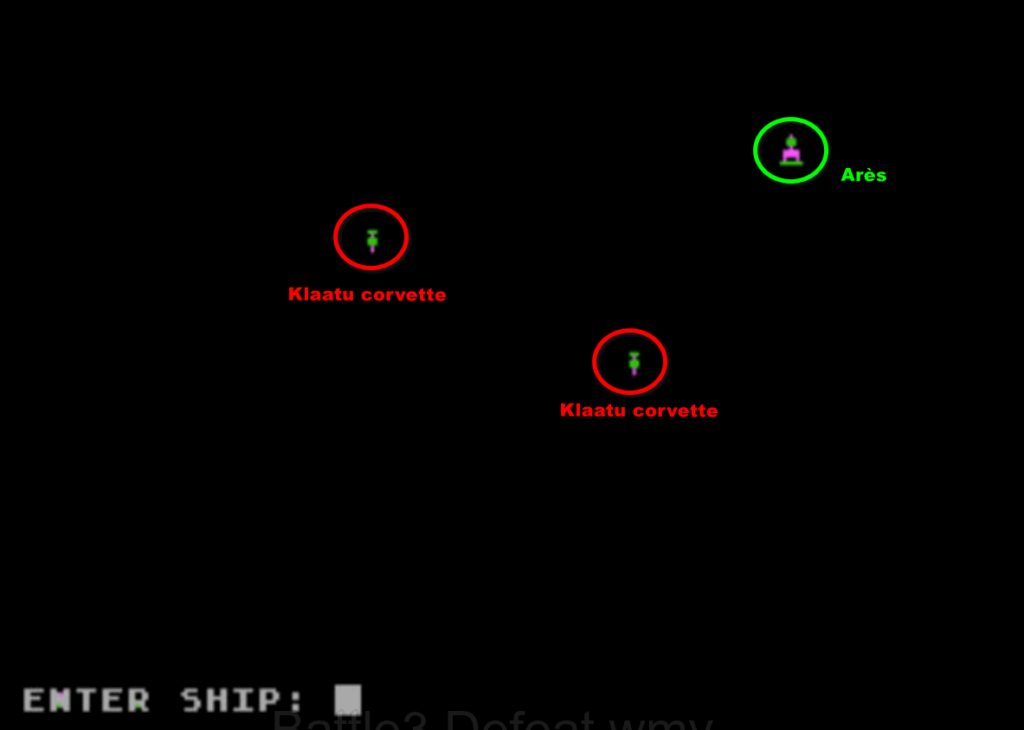
With only 15 in Energy, the commander of the Arès had to choose between speed, shield and attack. The commander decided was speed was tantamount to avoiding enemy missiles, and that closing-in and using the beam against the closest corvette was the most likely way to hit something and reduce the future number of incoming missiles. Only 1 energy was allocated to shield.
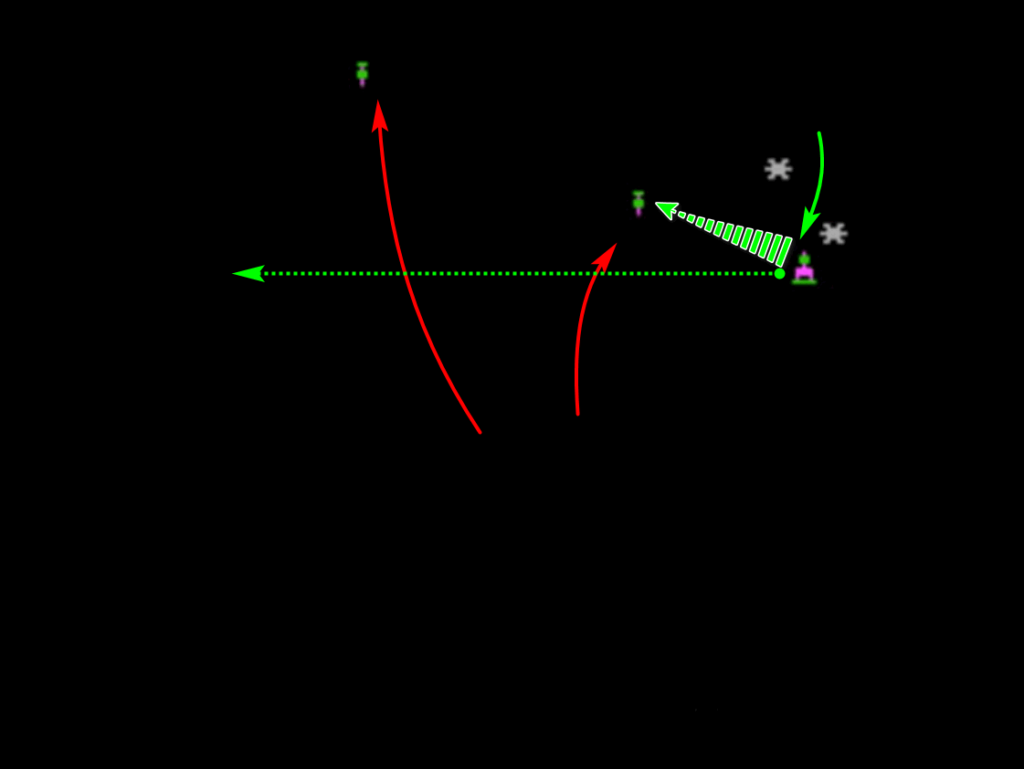
Some missiles exploded just behind the Arès, for minor damage.

The Klaatu had avoided a first torpedo, but it would not be lucky for long. The Arès managed to beam it from close range, annihilating it !
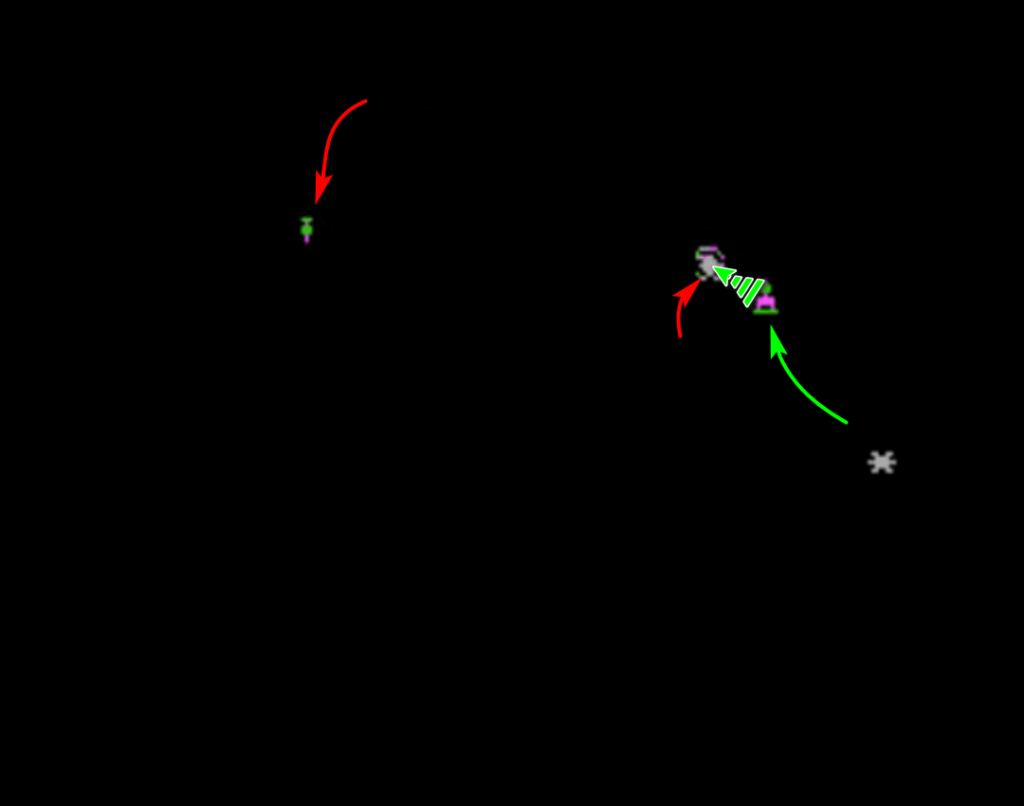
Having destroyed the first hostile, the Arès closed in to the second one. Her last torpedo missed, though :
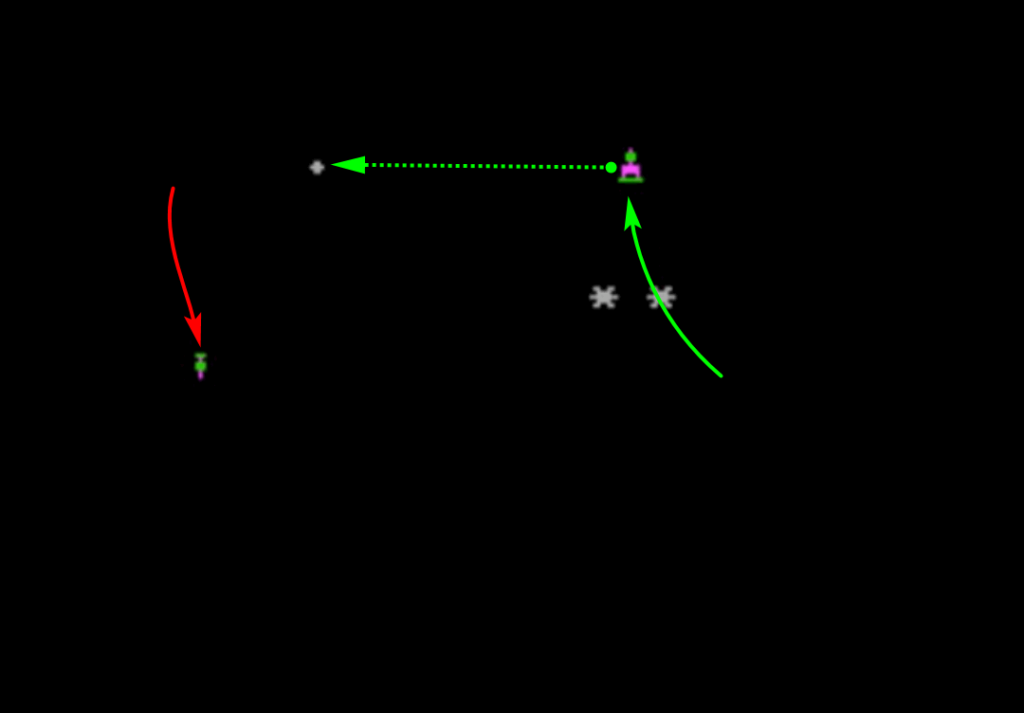
The commander of the Arès had to rely on either missiles or beams. Against a fast corvette of course, missiles would require luck. Beams less so.
But ironically, the Klaatus still had torpedoes … and it takes only one hit :
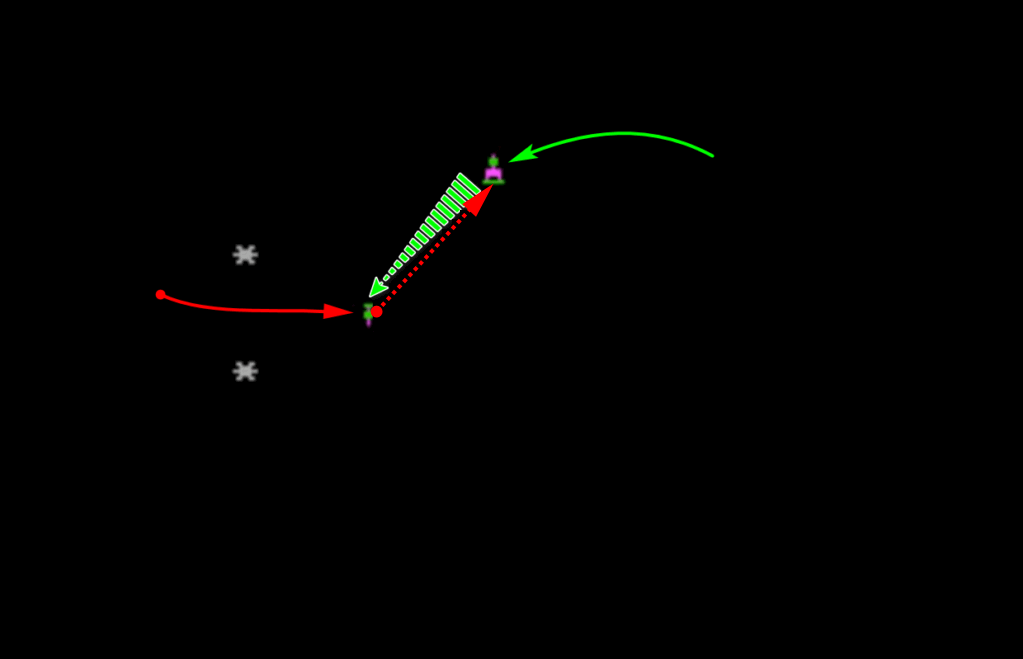

The Arès was heavily damaged, and now much slower than the corvette. The Klaatu took some distance and peppered the Arès with missiles. There were only close hits, but the situation onbard the Arès got worse and worse. Finally, the corvette closed-in …
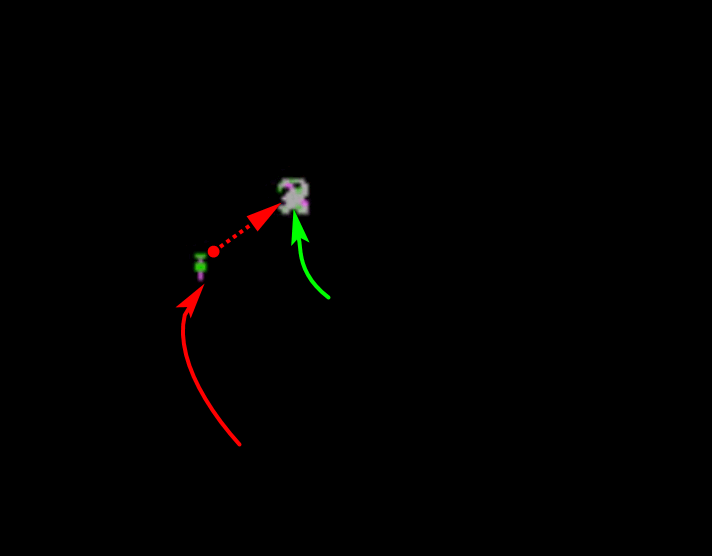
... and the Arès was gone.
This should be a lesson from you. Your ship may look sturdy, but if you get hit only once or twice by a missile or worse, a torpedo, then you will go down, because you will not be able to shield or to evade missiles any more.
Any question ? …
… Cadet Smith ?
- Is it true that it is onboard the Arès that the materials collected by the Eon Eagle were analyzed ? What happened to those materials ?
This information is highly classified Cadet Smith ! I take it there are no more questions and we will take a recess. After the recess, we will continue with our overview of our engagements against the Klaatus.
Some notes about the game : I play in Intermediate difficulty, after training on the two first scenarios (the ones with the Eon Eagle and the Camelot) I am now going through them game with only one attempt by scenario (more or less, honest order mistakes were not counted ; I redid the tutorial to check my “real” result) – to whether I should chalk the game as a win or not. As you will see, the game has more surprises…
Next part of the AAR here